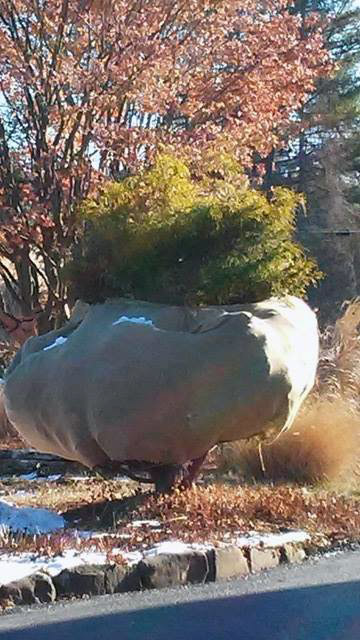
Caring for your trees and shrubs during the winter season will ensure a healthy and happy plant in the Spring. Here are a few tips on keeping your plantings well-maintained and beautiful for seasons to come.
Japanese Maples and thin barked trees
In the Winter months Deciduous trees and shrubs drop their leaves and go to sleep. They stop performing their processes and become dormant, but the harsh effects from wind and ice are the two most important factors to keep in mind when protecting your trees. Tree wrap is used to prevent sunscald injury which usually occurs during winter and early spring. Intense sunlight warms the surface of the trees to the point of stimulating cell activity in the bark, then a sudden drop in temperature at night can cause damage to the tree resulting in the condition known as sunscald. One way to prevent this, is by applying tree wrap in November. Start at the bottom of the trunk, overlapping the wrap as you wind it upward. Secure the end with a staple or small tack. In April, remove the wrap so insects or diseases aren’t tempted to move in. An easy way to remember: wrap by Thanksgiving and unwrap by Easter.
Evergreens
Some younger evergreens (while they establish themselves) and particular specimen may need some protection over the harsh Winter months to keep them healthy and at their top grade. In order for Evergreens to retain their beautiful color, they must continue executing their processes (photosynthesis) for the Winter months albeit they perform at a much slower rate. Which means that the tree will need access to moisture, makingdehydration and excessive transpiration a particular issue. If there hasn’t been much rain over the Fall season be sure to supplement, it is necessary to do it before the ground freezes otherwise the tree will not be able to absorb the water into the roots. Establishing an extensive root system can help allow the tree access to deeper ground level moisture, as well as putting mulch down in the Fall, as there is limited moisture in the frozen ground.
Windburn is one particular problem, it dries out the plant and the leaves on an evergreen. The leaves or needles will turn brown and die, this usually happens in the beginning of Spring when the ground is still frozen and the winds are still chilling but the warmth is causing the trees to start waking up, producing the need for more moisture. Any practice that promotes good root growth will help the plant meet its water needs. This can also be prevented by wrapping your trees in burlap, they can be wrapped individually or by making a screen. The burlap is used to protect from wind, sun, and salt residue it is best to leave the top open to allow for light. It is important to use a type of wrap that “breathes” and allows light and water in for the essential needs of the plant.
In late fall, when temperatures maintain an average above 40 degrees, you can also spray foliage of evergreen shrubs and small trees with an anti-transpirant such as Wilt-Pruf of Vapor Guard which provides a waxy layer that cuts down on water loss and minimizes winter injury. The spray needs to be reapplied during our spring thaw as well. It is best to apply on a day when the leaves can dry properly, ideally a sunny day, and ensure that the leaves top and bottom are thoroughly covered. Other precautions are avoiding placing susceptible plants where they will be exposed to wind. Any browned or dead areas of the tree, that have occurred over the winter, should be pruned back in the spring. New foliage will grow to fill in any gaps left by removing dead branches and foliage.






